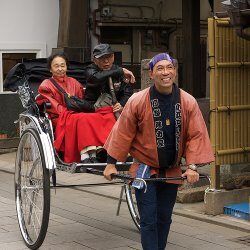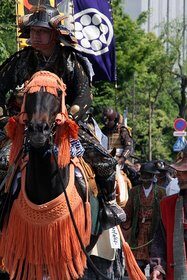History in Japan dates back to 35,000 BC – According to Japanese mythology the sun goddess Amaterasu, sent one of her off springs to the island of Kyushu to unify the people. People who live in Japan are considered to be descendants of people who arrived into Japan through Korea, Siberia and Taiwan/China. History of Japan indicates that Homo-sapiens migrated to the islands of what is now Japan through two natural bridges. These bridges were later covered by water.
Timeline of Japan’s History
10,000 BC – 300 – Jomon Period – More stable living patterns take place. Skillful fishing developed. Basic agriculture started. By late Jomon Period rice farming and government structure began for the first time in the history of Japan.
300 BC – 250 AD – Yayoi Period – Bronze tools first appeared and farming villages established.
Yamato Period –a turning point in Japan history- from tribes to a nation – 250 AD – 710 AD – the many small tribes were unified under the Yamato Dynasty, who established court in Nara. From this emperor till today the history of Japan counts 125 emperors. At that time Shinto, a religion native to Japan which consists of worship of nature and ancestors, was introduced. Shinto also gave divine status to the emperor. The Yamato dynasty were obsessed about hygiene, and invented the Japanese bath and sanitary ceremonies like burning a person’s house after his death (death was considered contaminating). After the death of the emperor the capital was moved to another place.
250 AD – 538 AD – Kufon Period – A Highly aristocratic society in the history in Japan, with militaristic leaders.
History in Japan in the 5th and 6th centuries – Asuka Period –the Chinese writing system and Buddhism were introduced with other Chinese cultures through the Korean peninsula. Buddhism flourished, and thousands of temples were constructed. Buddhism had tremendous influence on the arts.
Japan History During Nara Period
710 AD – 784 AD – Nara Period – the Capital was established in Nara. Before 710, the site of the capital was moved every time a new Emperor came to the throne. In 710 for the first time in the history of Japan, a permanent court was established in Nara. The Tang dynasty canceled the separate estates that created conflict between landowners. Emperor Taikwa turned Japan into one unified country with four different classes – the royal family, the noble, the citizens and the slaves. The emperors were the nominal rulers, but during the last years of Nara Period the actual power was held by Samurai, which were a military army created in order to protect the noble class. The Samurai were a very dominant force in the history in Japan.
A Brief History of Japan During Heian Period
784 AD – 1185 AD – Heian Period – Considered the peak in history in Japan of Imperial Court, art, poetry and literature. In 794, the capital was moved to Heiankyo – present-day Kyoto. Kyoto became capital for more than a thousand years. The Heian Period was an era of prosperity and peace in the history of the Japanese, allowing the noble class to attain new heights in the arts and culture. New ideas and practices flowed to Japan mainly from China, and were then modified to become uniquely Japanese. Chinese characters, for example, were used to create a new Japanese writing system. Towards the end of the Heian Period of Japanese history, military clans in the provinces began clashing for power, pushing Japan into a series of civil wars and eventually the feudal era. The Samurai gained power and turned from a military class created to protect, to a to a noble class of warriors.
The Feudal Time in the History of Japan
 1185 AD – 1333 AD – the feudal time of Japanese history (similar to Europe in the middle ages). The Kamakura Shoguns rule. Yoritomo, the head of the Genji clan, established a military government in a fishing village called Kamakura and became the first shogun in the history in Japan – a military leader. This marked the beginning of 700 years of japanese history with the dominance of the warrior class, known as Samurai and shogun rule. The Samurai were loyal to their feudal lord by a strict code of honor (Bushido) and led a Spartan lifestyle by the beliefs of Zen Buddhism, which advocated mental and physical discipline. The art and literature from that time reflect the rise of Samurai. The height of art at that time of Japan history was the creation of swords.
1185 AD – 1333 AD – the feudal time of Japanese history (similar to Europe in the middle ages). The Kamakura Shoguns rule. Yoritomo, the head of the Genji clan, established a military government in a fishing village called Kamakura and became the first shogun in the history in Japan – a military leader. This marked the beginning of 700 years of japanese history with the dominance of the warrior class, known as Samurai and shogun rule. The Samurai were loyal to their feudal lord by a strict code of honor (Bushido) and led a Spartan lifestyle by the beliefs of Zen Buddhism, which advocated mental and physical discipline. The art and literature from that time reflect the rise of Samurai. The height of art at that time of Japan history was the creation of swords.
1333 AD – 1336 AD – Kemmu Period – only three years between the end of Kamakura Shoguns and the rise of Ashikaga Shoguns.
1336 AD – 1573 AD – Muromachi Period – Muromachi or Ashikaga Shoguns rule until the 16th century. The emperor was practically powerless at that time in the history in Japan. The shoguns led an extravagant life, building villas like the Golden and Silver Pavilion and the rock garden which are still major attractions in Kyoto today. It was also a cultural time in the history of Japan, with Noh Theater, tea ceremony, flower arranging (Ikebana), architecture and landscape gardening. In the provinces the feudal lords competed for power. Impressive castles were built by feudal lords for defense and as a symbol of military strength and power. Eventually in 1467 there was an eruption of a long civil war that lasted for more than a century of Japanese history. The Muromachi Shoguns and power of Ashikaga were completely destroyed. A complete failure of social order came after.
1573 AD – 1603 AD – Azuchi-Momoyama Period – The name of this period of Japanese history comes from the names of shoguns castles – the Azuchi castle and the Momoyama castle. During 1543-1549 foreigners arrived to Japan for the first time. The Catholic Church began an ongoing attempt to convert the locals into Christians.
History in Japan in the Edo Period
 1600 AD – 1867 AD – The Edo period is known as the beginning of the modern Japan history. In 1603, Tokugawa Ieyasu, who emerged from the power struggle as the most powerful statesman in the land, established his shogun government in Edo – present-day Tokyo. To secure his domination, he produced laws that managed to keep feudal lords under control for another 260 years in the history in Japan. The feudal ministers were forced to show before the Shogun once every two years, and leave a family member as captive. The journey to Edo took a few months back and forth, so there was not much time left for conspiracies. The 13 Shoguns of that dynasty created peace and prosperity in Japan history at that time.
1600 AD – 1867 AD – The Edo period is known as the beginning of the modern Japan history. In 1603, Tokugawa Ieyasu, who emerged from the power struggle as the most powerful statesman in the land, established his shogun government in Edo – present-day Tokyo. To secure his domination, he produced laws that managed to keep feudal lords under control for another 260 years in the history in Japan. The feudal ministers were forced to show before the Shogun once every two years, and leave a family member as captive. The journey to Edo took a few months back and forth, so there was not much time left for conspiracies. The 13 Shoguns of that dynasty created peace and prosperity in Japan history at that time.
A Brief History of Japan and Its Contact with the West
During the 16th century, traders from Portugal, the Netherlands, England, and Spain arrived. So did Christian missionaries. In 1639, the Tokugawa shoguns adopted a policy of isolation in order to stabilize their power, and banned all international trade. The missionaries were thrown out of Japan. All locals who practiced Christianity were killed. The Japan history was cut off from the rest of the world.
All the progress made by western world between 17th and 19th century was unknown in the history in Japan. Japan lived a life cut off from the modern world, history in Japan had its own feudal system of samurai, farmers, craftsmen, and merchants. In 1853, Commodore Perry of the U.S. Navy sailed his fleet to the port of Uraga, near Edo, eventually forcing the shogun to enter into a trade agreement with the U.S. and cancel the period of isolation in the history in Japan. This sudden encounter with the West and its advanced technology contributed to the downfall of the Tokugawa shoguns and motivated Japan to catch up with the outside world.
Japan’s History During the Meiji Restoration
1868 included countless transformations in Japan history. The new emperor was only 16 years old, but he managed to form an industrial and military supremacy in a few years. Emperor Meiji moved his government from Kyoto to Tokyo and set Japan on a course of modernization that would transform the history in Japan from a feudal society to an industrialized nation in the course of only a few decades.
Western culture and influence flowed into Japan rapidly, including Western dress, food, architecture, industry, and more. The feudal system was eliminated, and many Western organizations were adopted. The four classes were canceled, and by initiating a compulsory military service the Samurai were left without a position for the first time in the history of Japan. Shinto became the formal religion of Japan, but the emperor also announced religious freedom, so Christianity was permitted. In 1904 Japan initiated war against Russia. The war ended with a victory for Japan. Russia surrendered Manchuria and more territories. Japan also canceled the independence of Korea. The Americans and British started to feel their power in the area was being hurt. Around that interesting time in Japan history emperor Meiji died.
1912 AD – 1926 AD – Taisho Period – Taisho was the son of Meiji. Two years after he became emperor Japan joined WWII. Japan used this war to conquer more areas in China. In 1918 an economical crisis developed in Japan. The great Kanto earthquake of 1923 in which 130,000 people died, wiped out Tokyo and Yokohama. Huge fires burnt the remains. This was the biggest disaster in the history of Japan.
History of Japan in Showa Period – A Time of Extreme nationalism
1926 AD – 1989 AD – Showa Period – the emperor was Hirohito – the grandson of Meiji. The economical crisis became worse, and right wing militarists demanded conquering more territories. Due to absence of natural resources, Japan felt a need to conquer resource-rich colonies leading to the invasion of China. Following the military success it was a time of extreme Fascism in Japan’s history. The Japanese people thrived for occupation of more territories. The peak was an attack on the US naval base in Pearl Harbor Hawaii (1941) that brought the United States to declare War on Japan. That was a turning point in the history of Japan. After a long and vicious Pacific fight the United States wiped out Hiroshima and Nagasaki with two atomic bombs. The bombs killed approximately 130,000 people instantly in Japan. History forced Emperor Hirohito to surrender to the United States on August 15, 1945.
The Americans allowed the emperor to remain in his position, as they feared panic and despair between the Japanese people. In the emperor’s radio announcement to the Japanese people he announced himself to be human and not a divine entity. The anouncement came as shock to Japanese people who considered the emperor a god all along Japan history.
1945 AD – 1952 AD – Occupied Japan -After being defeated in WWII Japan was occupied by allied troops mostly of US forces. Japan lost 2 million people during the war, and was in ruins. Japan had to give up all her occupied territories since the Meiji period. According to American demands the Japanese army was dismantled, and the education system was thoroughly changed. The emperors’ role was declared symbolic and Japan adopted a democratic constitution for the first time in Japan history.
History Of The Japanese Post-Occupion
5 years after the war the industry in Japan went back to its post-war level. The increase was mainly due to the Korean War, in which Japan was a major supplier to the NATO forces. Japan entered a period of peace and extremely rapid economic growth. It embarked on an extraordinary economic recovery that returned prosperity to the nation. Okinawa remained under US occupation until 1972, and a major military presence remains there to this day.
Japan became a significant power in industrial sections, including car manufacturing and the electronic goods. Tokyo hosted the 1964 summer Olympics, presenting to the world that Japan was a modern, industrialized nation.
Please note: the pictures at this page are provided under several Creative Commons licenses.
Return from History in Japan to TokyoTopGuide Homepage
Return from History in Japan to Tokyo History




